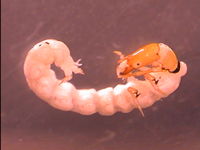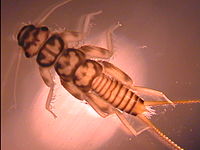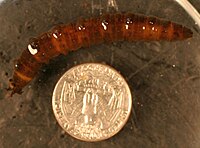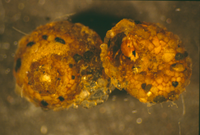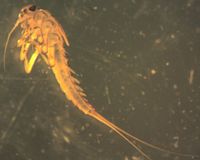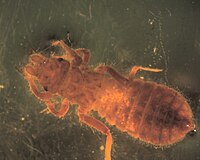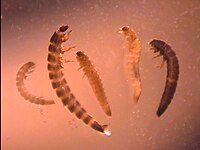Vermont EPSCoR's Streams Project; A Teacher Collaboration on WikiEducator
Openly shared content, practices, and developing resources from Vermont EPSCoR's Streams Project. Join this collaboration and make a difference!
 Lee River |
|---|
|
| Stream code: | LR_LeeRv_577 |
| Basin: | Winooski River Basin |
| State or Province: | Vermont |
| Latitude: | 44.480956 |
| Longitude: | -72.970943 |
| School: | Mount Mansfield Union High School |
This page is in need of additional work. If you have sampled this site please contact Declan (dmccabe@smcvt.edu) to add your sample to the database and iimprove this page. The following are the most common invertebrates collected from this stream site.
Chironomidae
- Order
- Diptera
- Family
- Chironomidae
- Common name
- Nonbiting midge
- Tied fly
- Griffith's Gnat
Midge larvae tend to be the most common macroinvertebrate at our sites. As with other Diptera, there are no true jointed legs. Chironomidae do have a pair of prolegs at each end and preserved individuals tend to curl into a 'C'. Identification past family requires slide-mounted heads. We have seen philopotamid caddisflies misidentified with the chironomids and we suspect that that happens when samples are being sorted from trays. Under a microscope, six prominent legs can be seen on members of the caddisfly family Philopotamidae.
More information on Philopotamidae.
Hydropsychidae
- Order
- Trichoptera (caddisfly)
- Family
- Hydropsychidae
- Common name
- net spinning caddisfly
- Tied fly
- Emergent Sparkle Pupa, Vermont Hare's Ear
This family of net-spinning caddisflies is very abundant at several sites. They are important filtering collectors and are quite common at urban and agricultural sites where particles of organic material can be important food resources. Genus-level identification is possible for mature specimens and we will include the genera we found at your site if possible.
When using the key, some features that are challenging to see are the forked trochantin and the paired sclerites in the folds between segments. Other, more easily seen key features include filamentous gills on the abdominal segments and the sclerotization of the dorsal surfaces of all three thoracic segments. Keep in mind that with smaller or more immature specimens, genus-level ID may not be possible.
Commonly found genera include Cheumatopsyche, Ceratopsyche, and Hydropsyche. Less commonly, we have found Arctopsyche and Potamyia.
Images of the forked trochantin and the paired sclerites.
Philopotamidae
- Order
- Trichoptera
- Family
- Philopotamidae
- Common name
- fingernet caddisflies
Philopotomidae are net-spinning filtering collectors. A casual observer might sort them with Chironomidae, but a close look reveals six jointed legs. The faint white 'T' shaped labrum extending from the front of the head past the mandibles is diagnostic for the family (it is sometimes withdrawn and hard to see).
Image of the faint white 'T' shaped labrum. Common genera include Dolophilodes, Wormaldia, and Chimarra.
Perlidae
- Order
- Plecoptera
- Family
- Perlidae
- Common name
- The Golden Stonefly Creeper
- Tied fly
- Connecticut Curler
This stonefly is characterized by the three pairs of filamentous gills located on the sides of all three thoracic segments. It is distinguished from the family Pteronarcyidae by the absence of gills on the abdominal segments. Often, the thoracic terga are brightly patterned as pictured, though this is not always the case. Another important feature is that the paraglossae and glossae extend different lengths.
Images of filamentous gills and the family Pteronarcyidae.
Genera commonly encountered in this family include Acroneuria, Agnetina, and Paragnetina. Less commonly, we have found Perlesta.
Very rarely encountered genera include Neoperla and Hansonoperla. If you believe you have found either of these, please send a specimen our way!
Template:Heptagenidae
Tipulidae
- Order
- Diptera
- Family
- Tipulidae
- Common name
- The Crane Fly
- Tied fly
- Gangle Legs
Like other larvae from the order Diptera, members of the family Tipulidae (crane flies) lack legs. Tipulidae have retracted, difficult-to-see head capsules at one end, and a spiracular disk at the other end. The spiracular disk can sometimes look like a face leading to some confusion about which end is which. Upon gently cutting the head open, one can see that the mandibles are not parallel to each other, but rather move against each other.
The genera we've encountered include Antocha, Dicranota, Hexatoma, Limnophila, Molophilus, Pedecia and Tipula.
Helicopsychidae
- Order
- Trichoptera
- Family
- Helicopsychidae
- Common name
- snailcase caddisfly
This caddisfly genus has one local species. It looks rather like a snail but has lots of sand grains covering it's 'shell' which is really a case. This is a great example of convergent evolution. The anal claws have closely-spaced teeth, much like a small comb.
Image of the closely-spaced teeth
Template:Pteronarcydae
Philopotamidae
- Order
- Trichoptera
- Family
- Philopotamidae
- Common name
- fingernet caddisflies
Philopotomidae are net-spinning filtering collectors. A casual observer might sort them with Chironomidae, but a close look reveals six jointed legs. The faint white 'T' shaped labrum extending from the front of the head past the mandibles is diagnostic for the family (it is sometimes withdrawn and hard to see).
Image of the faint white 'T' shaped labrum. Common genera include Dolophilodes, Wormaldia, and Chimarra.
Baetidae
- Order
- Ephemeroptera
- Family
- Baetidae
- Common name
- Small minnow mayfly
- Tied fly
- Tiny blue-winged olive
This mayfly has either two or three cerci ("tails") and a unique head shape. Its gills are oval shaped and insert dorsally. Commonly encountered genera include
Acerpenna,
Baetis and
Pseudocloeon.
More information on the genera:
Acerpenna
Baetis
Pseudocloeon
Gomphidae
- Order
- Odonata
- Family
- Gomphidae
- Common name
- clubtail dragonflies
Like other Odonata, members of this family have four wingpads. Like members of the sub-order Anisoptera, the abdomen terminates in five points. What distinguishes Gomphidae from Aeshnidae is the fact that Gomphidae has clubbed antennae.
Image of the four wingpads and the abdomen.
More information on Aeshnidae.
Elmidae
- Order
- Coleoptera
- Family
- Elmidae
- Common name
- riffle beetle
We very commonly find adult and larval riffle beetles. The adults are clearly beetles, but the larvae can be confused with other orders. The forward pointing tooth on the front end of the larvae as described in the key can be a challenge to see, particularly in small individuals. Larvae are characterized by having a single tarsal claw at the end of their legs, which have 4 segments. Adults, on the other hand, have two tarsal claws at the end of each leg. Commonly encountered genera include
Dubiraphia,
Macroychu,
Optioservus,
Phanocerus,
Promoresia, and
Stenelmis.
Images of the adult and larval riffle beetles.
More information on Dubiraphia, Macronychus, Optioservus, Phanocerus, Promoresia, and Stenelmis.


